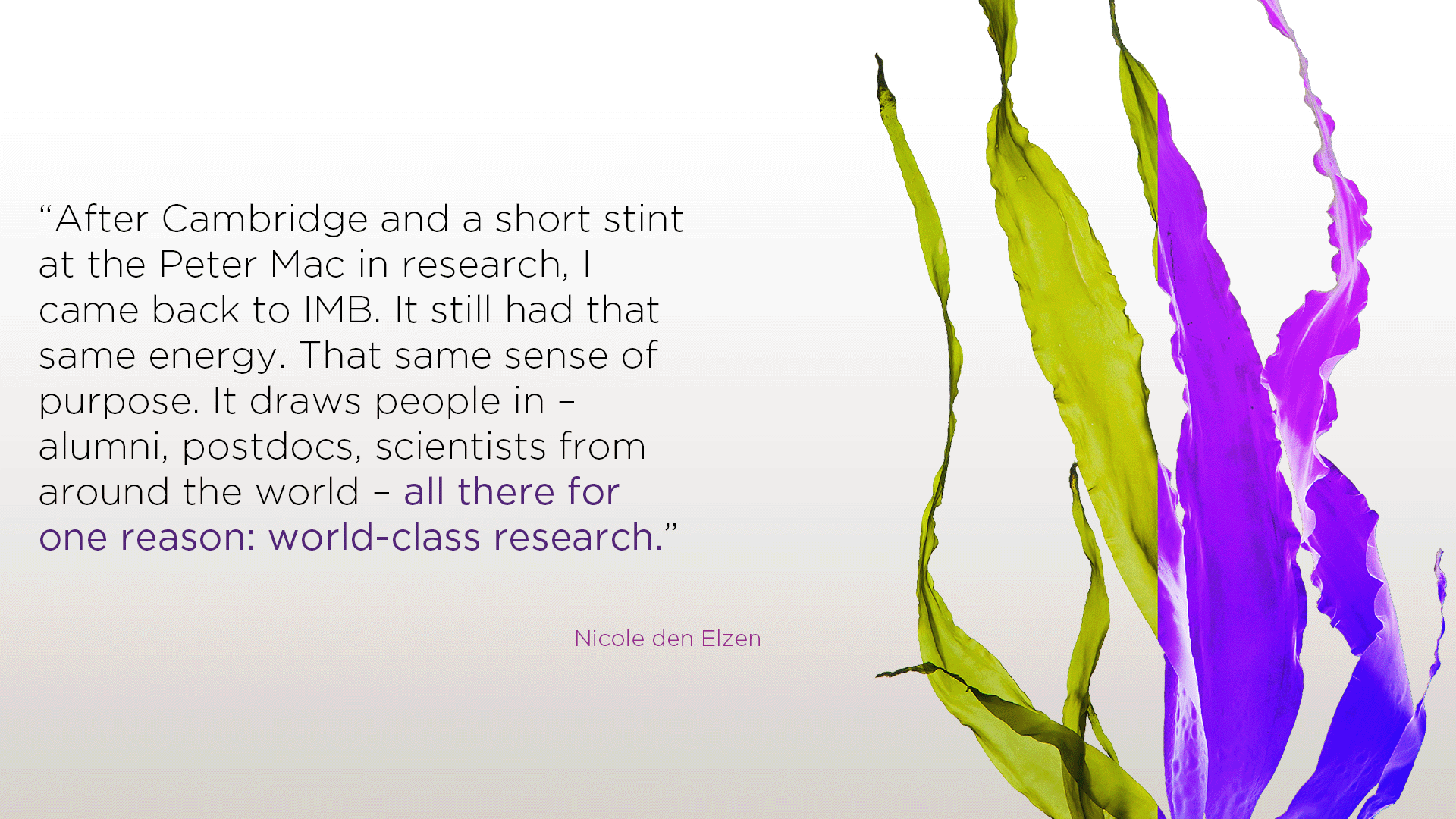Trading petri dishes for patients
Nicole’s journey from IMB to genetic counselling
When Nicole den Elzen reflects on her career path, she credits much of her direction, drive, and success to a place that felt like home from the very beginning. First at the Centre for Molecular and Cellular Biology (CMCB), and later at the Institute for Molecular Bioscience (IMB).
Now a genetic counsellor at the Peter MacCallum Cancer Centre in Melbourne, working in the field of haematology, Nicole helps patients understand the genetic landscape of blood-related conditions. It's meaningful, people-first work that builds on years of scientific exploration and personal discovery.
But before Peter Mac, before Cambridge, and even before her PhD, Nicole’s story started at CMCB, IMB’s precursor.
“When I was going through my science degree at UQ, CMCB was the place to do your honours,” Nicole says. “It was known for excellent molecular biology and medical research. It was innovative, and everyone wanted to be part of it.”
Nicole earned a coveted honours position under Professor David Hume. More than just an academic milestone, this experience sparked a deep sense of belonging.
“It felt like you were part of something important – working with incredibly smart, passionate people,” she reflects.
It was also a pivotal moment: Professor Hume encouraged Nicole to pursue a PhD overseas, a less common path at the time. She took the leap and completed her PhD at the University of Cambridge, one of the world’s leading research institutions. The international experience was formative, and she returned to Australia eager to join an institute that shared the same pursuit of innovation and excellence.
“After Cambridge and a short stint at the Peter Mac in research, I came back to IMB. It still had that same energy. That same sense of purpose. It draws people in – alumni, postdocs, scientists from around the world – all there for one reason: world-class research.”
She stayed at IMB for four years as a postdoctoral researcher in Professor Alpha Yap’s lab. That time shaped not only her scientific skillset but also her sense of professional identity.
“There’s a buzz in places like IMB,” Nicole says. “You live and breathe the work. You feel part of something innovative and meaningful. And the facilities, cutting-edge equipment, great microscopy platforms – they enable research that can really change things.”

Eventually, Nicole took a new path into the Queensland Government, where she worked under the visionary Professor Peter Andrews AO, the founding Director of the IMB, who later became Queensland Chief Scientists. It marked a pivotal transition from the bench to science strategy and project management, a move that allowed her to broaden the impact of her scientific expertise.
“Leaving science can be a tough call,” Nicole admits, “but Peter made that transition inspiring. He brought this infectious energy and a fearless approach to big change.”
Professor Andrews, a 2023 Queensland Great, left a lasting impression on Nicole – not just for his impact across science, biotech, and research in Queensland, but for his vision and integrity.
“He wasn’t driven by ego. He was focused on what could make the biggest difference for Queensland, for science, for the future.”
That ethos, Nicole believes, was built into IMB from the very beginning. It’s what made the institute such a magnet for talent and innovation.
“Places like IMB, like Peter’s vision – they attract the best people. Not just because of the facilities, but because of that international, energetic community that believes in doing important work.”
Today the passion she cultivated in those early years at CMCB, IMB, and beyond continues to guide her.
“It’s all part of the same story,” she says. “Of being in places that challenge you, inspire you, and remind you that what you’re doing matters.”
For Nicole, the transition from research to counselling wasn’t the end of her scientific story, it was a continuation. The sense of curiosity, purpose, and community that defined her early years at IMB now lives on in the way she supports patients and families every day. Her path reminds us that the influence of places like IMB extends far beyond the lab bench, shaping lives and legacies across every corner of science and society.
